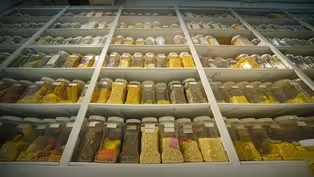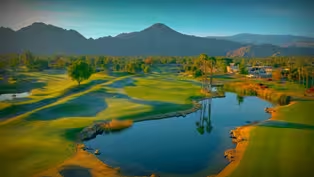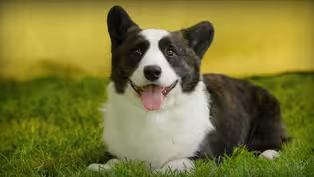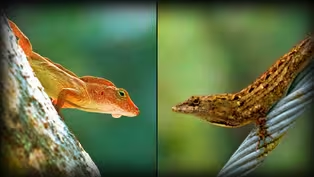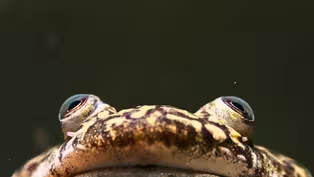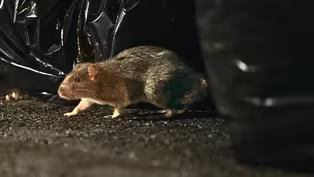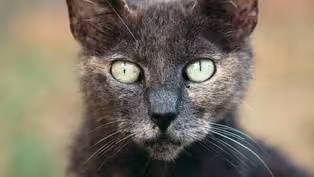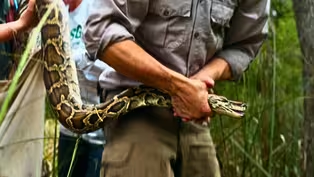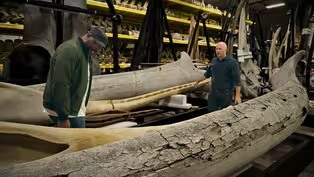
Sled Dogs: The Most Extreme Distance Athletes on Earth
Special | 15m 17sVideo has Closed Captions
In the Arctic, it's not just about muscle power, but brainpower too.
In the Arctic, it's not just about muscle power, but brainpower too. The bond between humans and sled dogs goes beyond physical strength. It's a testament to our shared intelligence and teamwork throughout history. Keep watching to learn how sled dogs have evolved over millennia to become the ultimate Arctic warriors.
Problems playing video? | Closed Captioning Feedback
Problems playing video? | Closed Captioning Feedback

Sled Dogs: The Most Extreme Distance Athletes on Earth
Special | 15m 17sVideo has Closed Captions
In the Arctic, it's not just about muscle power, but brainpower too. The bond between humans and sled dogs goes beyond physical strength. It's a testament to our shared intelligence and teamwork throughout history. Keep watching to learn how sled dogs have evolved over millennia to become the ultimate Arctic warriors.
Problems playing video? | Closed Captioning Feedback
How to Watch Human Footprint
Human Footprint is available to stream on pbs.org and the free PBS App, available on iPhone, Apple TV, Android TV, Android smartphones, Amazon Fire TV, Amazon Fire Tablet, Roku, Samsung Smart TV, and Vizio.
Buy Now

Surprising Moments from Human Footprint
Do you think you know what it means to be human? In Human Footprint, Biologist Shane Campbell-Staton asks us all to think again. As he discovers, the story of our impact on the world around us is more complicated — and much more surprising — than you might realize.Providing Support for PBS.org
Learn Moreabout PBS online sponsorshipMore from This Collection
Human Footprint is a show that delves into the impact of humans on the planet. Join Shane as he travels from farms to restaurants, from high-tech labs to street markets, and from forests to cities to uncover the consequences of our unique history. Are you ready to explore our past, present, and future as a species?
Video has Closed Captions
Watch the rise of a productive crop that has managed to replace itself, but at what cost? (11m 24s)
The Watery Price Of Golf Courses & Lawns
Video has Closed Captions
The cultural and resource costs for manicured lawns and golf courses are quite shocking. (11m 29s)
How Dogs Are Shaping The Future Of Medicine
Video has Closed Captions
Observe the rich diversity of dog breeds, shaped by genes and human intervention. (12m 43s)
We Brought This Fish To America. Now We Can't Get Rid Of It
Video has Closed Captions
Expose Asian carp for disrupting native fish species and shrinking their populations. (10m 39s)
Why Are These Urban Lizards Evolving in Overdrive?
Video has Closed Captions
Examine city-dwelling anoles with remarkable evolutionary changes. (10m 33s)
How An Ancient Ocean Shaped Us History
Video has Closed Captions
Learn how millions of years of deposits shaped the events of Black American history. (16m 54s)
Video has Closed Captions
What happens when frogs become indispensable? (8m 59s)
Video has Closed Captions
When it comes to NYC, the rat is the undisputed king! (13m 26s)
Your Cat’s Secret Life (as a Deadly Predator)
Video has Closed Captions
Cats have been winning the hearts of humans for years....but can devastate ecosystems. (10m 40s)
Singapore: Designing a Megacity in Harmony with Nature
Video has Closed Captions
Green spaces aren't just an afterthought here - they're mandatory! (13m 24s)
How Giant Pythons Became Florida’s Biggest Invasive Species
Video has Closed Captions
Ever heard of the phrase "when pet pythons outgrow their owners"? (13m 24s)
Secrets of the World’s Only Whale Warehouse
Video has Closed Captions
Uncover the history of whaling and its impact on our oceans. (9m 58s)
Providing Support for PBS.org
Learn Moreabout PBS online sponsorshipDoes this make you nervous at all?
Naw.
But if you were out here without the dogs, would you be nervous?
Yeah.
What's he doing?
I'm looking at him and he's looking at me.
Dogs have been a part of our lives for longer than any other animal or plant species on Earth.
Today, most of our dogs need us more than we need them.
But not all of them.
North of the arctic circle, an ancient alliance with dogs still means the difference between life and death.
Extreme conditions call for extreme feats of speed and endurance.
So just how do these dogs and their human handlers perform at such an elite level?
Come join me, a skilled musher, and a bunch of dogs in the Canadian Arctic to see for yourself.
I’m Shane Campbell-Staton, and this is Human Footprint.
One day we saw these wolves and they were faster.
They had better smell than us.
They could hear better than us.
So we're like, oh, why don't we befriend this animal?
Thousands of years later, they're still by our side.
And without them, my people wouldn't survive.
They’re part of who we are.
Dogs.
Shhhhhh….
The sled dog is an animal created, and relied upon, by us.
Countless generations of evolution have transformed them into the perfect Arctic ally… and one of the fastest long-distance runners on the planet.
The first evidence of people and their dogs settling in the Arctic dates back 4,500 years.
Ever since, a combination of natural selection and selective breeding reshaped Inuit Sled Dogs to withstand the most extreme conditions in these punishing environments.
Fully grown, these dogs weigh anywhere from 65 to 90 pounds.
They sport a dense undercoat which keeps them warm in sub-zero temperatures.
Their overcoat, also called a ‘guard hair coat’, helps the dogs keep snow and ice off of their fur in windy conditions.
Basically, you can wear all the high-tech outerwear you want… Inuit Sled Dogs are still gonna be warmer than you.
These dogs belong to my guide, Devon Manik.
He’s a normal 21-year old… Loves listening to music, cruising the web… You know, when he’s not out in the bone-chilling cold, doing what it takes to survive here.
Look at those adorable, bloody little faces.
They’re no pet dog, aye?
Do they prefer raw meat over kibble?
If I feed them kibble, they'll start losing weight.
Meat is what keeps them going.
I feed them whatever I hunt.
So they eat the whole animal.
Over millennia, dogs like Devon’s evolved into a creature the planet had never seen.
A single sled dog on a hunt or a race can consume 12,000 calories per day.
They efficiently process a protein- and fat-rich diet to supply their muscles with the sugar glucose.
By comparison, the recommended intake for humans is anywhere between 1,600 and 3,000 calories a day!
Scientists are still figuring out the biochemical details, but the results are hard to argue with: on a week-long hunt, a team of dogs can pull a loaded sled across hundreds of miles of snow and ice, all while finding prey and protecting hunters from polar bears.
With these dogs at our sides, humans unlocked life above the Arctic Circle.
What do you imagine it was like for the first people that colonized this place without dogs?
A lot of work.
A lot of work, because there’s just not a lot to eat up here.
And what little there is, doesn’t give up easy.
So if you're ever lost in the Arctic, make sure you have muktuk.
It has all the vitamins you need so you won't get scurvy.
Mavis is Devon’s mom, and an expert in all the delicacies the Arctic has to offer.
What is this?
Whale skin.
It's very oily.
And oceany.
Oily and oceany.
I like that.
I like that.
So you could take that piece.
Okay.
This?
Yeah.
Is it oily and oceany?
Wow.
It is both oily and oceany.
Yeah, that was a great description.
Belugas are cute and all, but they taste really good, too.
How old were you when you started hunting?
I got my first seal when I was eight.
Wow.
For thousands of years, whether it’s across the sea ice… or on land… dogs have been an essential part of any hunting expedition here.
So what I was about to eat, is only here because of that human-canine alliance.
Frozen musk ox meat from the leg.
Meat is very high in our diet.
Makes up like 95% of it.
Between Devon’s family’s diet, and the diets of his dogs, meat is life.
And it takes that partnership to bring it to the table for both species.
Thanks Momma.
You’re welcome.
Thank you so much I have the best mom in the world.
Wild carrots.
She picked them just right across the street.
You better leave your mom alone.
Yeah!
Choke on your musk ox.
Devon’s community has first-hand experience of life without dogs… but not by choice.
It's the tail end of the brief summer, so-called, that they get on Cornwallis Island, 75 degrees north.
They've named the place Resolute.
In the 1950s, the Canadian government established a permanent settlement here to secure their claim to the land.
So they relocated families from northern Quebec all the way up here.
And they were Inuit.
But where they live, there's trees growing.
So coming all the way up here, where there's barely any vegetation, was really hard for them to live up here.
They were promised so much and when they got here, they were living in canvas tents over the winter.
Then the RCMP killed all the sled dogs.
The RCMP, or Royal Canadian Mounted Police, killed hundreds of sled dogs, keeping the newly relocated Inuit from hunting or traveling outside of town.
Since they evolved with us, the dogs need us to survive, we need them to survive.
And they were like so close to being extinct.
So close.
Without dogs, the people’s livelihoods – and their culture itself – began to erode.
It's a very dark history how Resolute became.
But in the last about ten years maybe they've had like a revival of the sled dogs.
When did you start using a sled dog team?
I was 16.
I had one dog.
My mom got me a dog, actually.
We're in a high polar bear environment.
So all I thought was, you know, they were just chasing my little boy.
Oh wow.
And I used to take him out of town and he had a sled and he would pull us home.
My mom would tie me to the bed before she let me do something like that.
Devon gradually grew his team from one dog to 16.
Most of them are Inuit sled dogs… the OG of the Arctic.
It's a very old dog breed from about a thousand years ago.
They came along with the Inuit, from Siberia to Alaska, all the way up to here.
But after the near extinction of the Inuit sled dog, there weren't many elders in Resolute to teach Devon how to hunt the old way.
So he turned to Gen-Z’s most trusted source of information.
I used to watch videos on YouTube of Greenland mushers.
I tried to do how they did it.
You learned how to run a sled dog team from YouTube?
Well, not entirely, but it was a part of it.
Yeah.
I learned how to bake like cinnamon rolls on YouTube once.
What can I expect out on this hunt?
At first it'll be chaos.
I have legitimately never seen and definitely never heard anything like this before…Yeah, these boys are ready to go.
Yeah, adult fights get pretty nasty.
If I don't stop them, they’ll try to kill each other.
It’s uh, game time out here.
Let’s put the bear skin on.
Yeah, you might as well not even come out here if you're not going to put the bear skin on it.
Two more left.
When I put one on, in the last run, you get on the sled.
Okay.
Just hold on for dear life when you’re going.
They should start slowing down once we get onto the flat ice.
I'm usually hunting alone.
Just me and the dogs.
They don’t care about anything else.
They just want to pull.
We can’t survive without each other.
We're heading out.
It's called Resolute Passage.
So it's between here and Griffith Island.
And we're gonna just follow some cracks.
Go out wherever the seals are.
Even in this featureless white landscape, Devon and the dogs knew where the seals would be.
See a seal way out there.
We’re gonna grab the gun and we’re gonna stalk it.
On foot?
Yeah.
What do you need me to do?
Haha, watch.
Just watch?
Yeah.
Okay.
But you can follow me.
How close will you try to get to the seal?
100 to 200 yards.
I’ll be back.
God it’s cold out here.
This animal that he’s hunting now, is physiologically built to live in one of the most extreme environments on the planet.
And in the same way these dogs.
We had to stop because they were overheating out here.
If you rewind the clock a thousand years, without a team of dogs like that, I have no idea how anyone could survive.
He’s about to take a shot.
I couldn't get a clear shot, there’s too many snow drifts in the way.
You gonna go for a swim?
No, no.
hell no.
If the seals are gone, they're gone.
We move on!
It’s frustrating.
If I don't get a seal, I can’t feed my dogs.
This time of year, the sun doesn't set… but Devon knows when to call it a day.
It's after midnight… definitely time to make camp on the ice.
So this is how you secure dogs if you don't have an ice screw.
You just… chisel out two holes in the ice and you make them meet.
Is there anything I can do to help?
Look out for bears for me.
Okay.
Yeah.
That’ll hold.
Then, sure enough, an off-white object appeared on the horizon.
How do you feel about being hunted by a polar bear?
Oh my God.
That is actually a polar bear.
Wow!
It's just like I remember from the Coca Cola commercials.
I wish I could go back and talk to 13-year-old me and tell myself what was coming.
I'd flip out.
I’m flippin’ out now.
Easily the coolest wildlife I've ever actually seen in the wild.
Once he figures out what we are, he'll probably move on… unless he's starving.
These guys love hunting bears, so they’re really great alarms.
Maybe he caught a whiff of the dogs.
I hope.
Devon’s dogs are unlike anything I’ve seen before.
Humans transformed them into workhorses that haul massive loads over vast distances in the harshest environment on the planet… But they transformed us too.
By opening up the Arctic, these dogs became the foundation of a unique culture found nowhere else.
If you want more Human Footprint, you can tune in to the full length series on the PBS App or your local PBS station.
Check out the link in the description to watch a full episode and to find out more about the show.

- Science and Nature

Capturing the splendor of the natural world, from the African plains to the Antarctic ice.

- Science and Nature

Explore scientific discoveries on television's most acclaimed science documentary series.












Support for PBS provided by:
